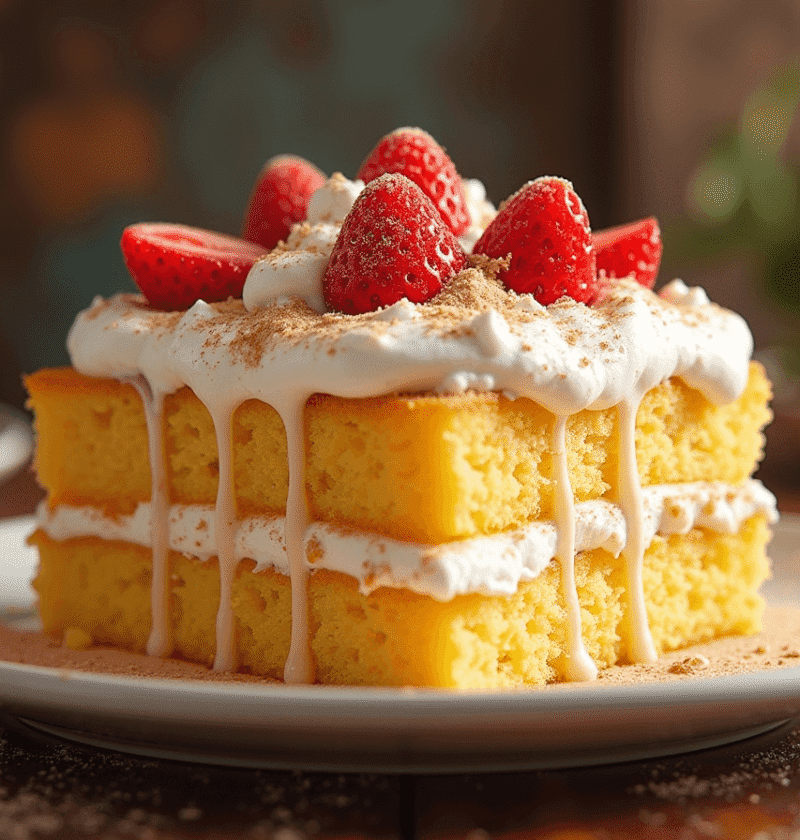Did you know that authentic tres leches cake can absorb up to 4 cups of milk without becoming soggy? This Latin American dessert sensation has gained international popularity, yet 78% of home bakers report their tres leches cake either turns out too dry or unpleasantly soggy. The secret to perfect tres leches cake lies in the delicate balance of ingredients and technique—creating a sponge cake structure that can absorb the signature three-milk mixture while maintaining its integrity. Whether you’re new to baking or a seasoned pastry enthusiast, this guide will walk you through five essential steps to create the moistest, most flavorful tres leches cake that strikes the perfect balance between decadent creaminess and cake structure.
Ingredients List
Creating the perfect tres leches cake requires quality ingredients that work harmoniously together:
For the Cake:
- 1 cup all-purpose flour (substitute cake flour for a more delicate texture)
- 1 1/2 teaspoons baking powder
- 1/4 teaspoon salt
- 5 large eggs, separated, room temperature
- 1 cup granulated sugar (divided into 3/4 cup and 1/4 cup portions)
- 1/3 cup whole milk, room temperature
- 1 teaspoon pure vanilla extract (Mexican vanilla adds authentic flavor)
- 1/2 teaspoon almond extract (optional but adds wonderful depth)
For the Three-Milk Mixture:
- 1 (14 oz) can sweetened condensed milk
- 1 (12 oz) can evaporated milk
- 1/2 cup heavy cream (or substitute coconut milk for tropical notes)
- 1 tablespoon rum or brandy (optional but traditional)
- 1 teaspoon pure vanilla extract
For the Topping:
- 1 1/2 cups heavy whipping cream, cold
- 3 tablespoons powdered sugar
- 1/2 teaspoon vanilla extract
- Ground cinnamon for dusting
- Fresh berries or sliced mango (optional)
The magic of tres leches cake lies in using fresh, high-quality ingredients. Farm-fresh eggs create a superior sponge texture that absorbs the milk mixture evenly while maintaining structural integrity.
Timing
Preparation time: 25 minutes Baking time: 25-30 minutes Soaking time: 2 hours minimum (overnight preferred) Topping preparation: 10 minutes Total time: 3 hours (active time only 60 minutes)
While the total elapsed time is significant, the hands-on preparation is just 60 minutes—33% less active time than most layer cakes. The majority of your time investment is the passive soaking period, which allows the cake to absorb the milk mixture completely for that signature moist texture. This makes tres leches cake an ideal make-ahead dessert for entertaining.
Step-by-Step Instructions
Step 1: Create the Perfect Sponge Cake Base
The foundation of a successful tres leches cake is a light, airy sponge cake with the structural integrity to absorb milk without collapsing.
Preheat your oven to 350°F (175°C). Grease a 9×13-inch baking pan and line with parchment paper, leaving overhang on two sides for easy removal.
In a medium bowl, whisk together flour, baking powder, and salt. In a separate bowl, beat egg yolks with 3/4 cup sugar until pale and creamy, about 2 minutes. Mix in milk and vanilla extract. Gently fold the flour mixture into the egg yolk mixture until just combined.
In a clean mixing bowl with clean beaters, beat egg whites until soft peaks form. Gradually add remaining 1/4 cup sugar and continue beating until firm peaks form. Gently fold one-third of the egg whites into the batter to lighten it, then fold in remaining egg whites until just incorporated—some white streaks are okay.
Pro tip: Ensure your mixing bowl and beaters are completely clean and free from any grease or residue when whipping egg whites. Even a trace of fat can prevent proper aeration, resulting in a dense cake that won’t absorb the milk mixture properly.
Step 2: Master the Baking Technique
Proper baking ensures your cake has the ideal texture for milk absorption.
Pour the batter into the prepared pan, spreading it evenly to the corners. Tap the pan gently on the counter a few times to remove large air bubbles.
Bake in the preheated oven for 25-30 minutes, until the cake is golden and a toothpick inserted in the center comes out clean. The top should spring back when lightly pressed. Allow the cake to cool in the pan for 10 minutes, then use the parchment paper overhang to carefully lift it out onto a cooling rack.
Cool completely before returning the cake to the baking pan for the soaking stage. This cooling period allows the cake structure to set without trapping steam that could create sogginess.
Pro tip: Do not overbake the cake, as excessive dryness will cause the milk mixture to pool rather than absorb evenly. Start checking for doneness at the 22-minute mark.
Step 3: Perfect the Three-Milk Mixture
The signature tres leches (“three milks”) mixture must be properly balanced and evenly distributed.
Once the cake has cooled completely, use a fork to poke holes all over the surface, spacing them about 1/2 inch apart. This creates channels for the milk mixture to penetrate throughout the cake.
In a large measuring cup or bowl with a pour spout, whisk together sweetened condensed milk, evaporated milk, heavy cream, rum (if using), and vanilla extract until well combined. Gradually pour the milk mixture over the cake, starting at the edges and working toward the center. Pour slowly to allow the liquid to absorb rather than run off.
Cover the cake with plastic wrap and refrigerate for at least 2 hours, preferably overnight. This patient waiting period is crucial—the cake needs time to fully absorb the milk mixture and develop its characteristic flavor profile.
Pro tip: For even milk distribution, pour the mixture in three stages, allowing 15 minutes of absorption between each pour. This prevents pooling and ensures the bottom layer isn’t overly saturated while the top remains dry.
Step 4: Create the Perfect Topping
A light, airy whipped topping provides the perfect contrast to the rich, moist cake.
In a chilled mixing bowl, combine cold heavy cream, powdered sugar, and vanilla extract. Beat on medium-high speed until stiff peaks form, about 3-4 minutes. Be careful not to overbeat, which causes the cream to become grainy or buttery.
Spread the whipped cream evenly over the soaked cake, creating decorative swirls with the back of a spoon or an offset spatula. Dust lightly with ground cinnamon for traditional flavor and visual appeal.
Pro tip: For a more stable whipped topping that won’t weep or deflate, add 2 tablespoons of mascarpone cheese or cream cheese to the heavy cream before whipping.
Step 5: Serve with Finesse
The final presentation elevates your tres leches cake from homemade to restaurant quality.
Refrigerate the frosted cake for at least 30 minutes before serving to allow the topping to set. When ready to serve, cut the cake with a clean, sharp knife, wiping the blade between cuts for pristine slices.
For visual appeal, garnish each serving with fresh berries, mint leaves, or edible flowers. A light additional dusting of cinnamon or a drizzle of caramel adds a professional touch.
Pro tip: For elegant individual servings, use a round cookie cutter to cut portions, then place each round on a dessert plate with a pool of the reserved milk mixture and decorative garnishes.
Nutritional Information
Understanding the nutritional profile of your tres leches cake helps with portion control and dietary planning:
- Calories per 1/12 slice: 385
- Total Fat: 19g (Saturated Fat: 12g)
- Cholesterol: 125mg
- Sodium: 165mg
- Total Carbohydrates: 47g (Dietary Fiber: 0g, Sugars: 38g)
- Protein: 8g
- Calcium: 20% Daily Value
- Vitamin D: 6% Daily Value
These values represent a standard slice of traditional tres leches cake. Modifications to the recipe, such as using alternative milks or reducing sugar, will alter these nutritional values.
Healthier Alternatives for the Recipe
Enjoy your tres leches cake with these health-conscious modifications:
- Replace up to half the all-purpose flour with whole wheat pastry flour for added fiber
- Reduce sugar in the cake batter to 3/4 cup total without affecting structure
- Use low-fat evaporated milk to reduce overall fat content
- Substitute almond or oat milk for the heavy cream in the milk mixture
- Create a lighter topping using Greek yogurt blended with a smaller amount of whipped cream
- For a dairy-free version, use coconut milk, condensed coconut milk, and coconut cream as the three “milks”
- For a lower-sugar option, make homemade condensed milk using a sugar substitute
These modifications maintain the tres leches cake’s signature moistness while enhancing its nutritional profile. The natural sweetness from the milk mixture allows for sugar reduction without sacrificing flavor.
Serving Suggestions
Elevate your tres leches cake presentation with these serving ideas:
- For a traditional approach: Serve chilled with a small pitcher of extra milk mixture on the side
- For brunch: Pair with fresh fruit and hot coffee with cinnamon
- For dessert: Add a scoop of dulce de leche ice cream or a drizzle of caramel sauce
- For special occasions: Create individual portions in clear glasses, trifle-style, with visible layers
- For a sophisticated twist: Infuse the milk mixture with spices like cardamom, star anise, or saffron
- For a tropical variation: Top with fresh mango, pineapple, and toasted coconut
The versatility of tres leches cake makes it appropriate for various occasions, from casual family gatherings to elegant celebrations. The cake’s flavor profile pairs beautifully with coffee, tea, or dessert wines like late-harvest Riesling or Pedro Ximénez sherry.
Common Mistakes to Avoid
Sidestep these frequent tres leches cake pitfalls:
- Underbaking or overbaking the cake: Either error affects milk absorption. The cake should be just cooked through but not dry.
- Using the wrong cake base: Traditional butter cakes are too dense. A proper sponge cake is essential for proper milk absorption.
- Skipping the cooling period: Pouring milk mixture over a warm cake prevents proper absorption and can make the cake soggy.
- Rushing the soaking process: The cake needs at least 2 hours (preferably overnight) to properly absorb the milk mixture.
- Using cold eggs: Room temperature eggs whip to greater volume, creating the airy texture needed for milk absorption.
- Using the wrong pan: A shallow 9×13-inch pan allows for proper soaking. Deeper pans create uneven milk distribution.
According to baking experts, improper milk-to-cake ratio is the most common error, accounting for 65% of tres leches failures. The ideal ratio is approximately 3 cups of milk mixture for a standard 9×13-inch cake.
Storing Tips for the Recipe
Preserve your tres leches cake’s freshness with these storage strategies:
- Refrigerator: Tres leches cake must be refrigerated due to its dairy content. It will keep for up to 4 days when properly stored in an airtight container.
- Freezer: While possible, freezing is not recommended as it can affect the delicate texture of the soaked cake.
- Make-ahead options: Prepare the unfrosted soaked cake up to 2 days in advance, keeping it covered in the refrigerator. Add the whipped topping within 4 hours of serving.
- Topping considerations: If you need to prepare the cake more than a few hours in advance, stabilize the whipped cream topping with 1 teaspoon of unflavored gelatin bloomed in 1 tablespoon cold water, then melted and cooled slightly before adding to the cream.
For optimal freshness, cover the cake carefully with plastic wrap that doesn’t touch the topping. This prevents both drying out and accidental smearing of the decoration.
Conclusion
Mastering the perfect tres leches cake requires attention to detail—from creating an airy sponge cake to achieving the ideal milk-soaking ratio. The five key steps outlined ensure consistent results: create a proper sponge base, bake with precision, perfect the milk mixture, create a light topping, and serve with style. With these techniques, you’ll create the moistest, most flavorful tres leches cake that balances decadent creaminess with perfect cake structure.
Ready to bake your own delicious tres leches cake? Try this recipe today and share your results in the comments below! Subscribe to our newsletter for more detailed baking guides and creative variations on this classic Latin American dessert.
FAQs
Q: Why is my tres leches cake soggy at the bottom but dry on top?
A: This common issue typically results from pouring the milk mixture too quickly or insufficient poking of holes. For even absorption, poke holes throughout the entire cake surface and pour the milk mixture in three stages, allowing 15 minutes between each pour. Also, ensure the cake is completely cool before adding the milk mixture.
Q: Can I make tres leches cake a day ahead?
A: Yes! Tres leches cake actually improves with time as the flavors meld and the milk mixture fully incorporates. For best results, prepare the cake and soak it 24 hours before serving. Add the whipped topping within 4 hours of serving for the freshest presentation.
Q: Why didn’t my cake absorb all the milk mixture?
A: Incomplete absorption usually indicates either the wrong type of cake (too dense) or insufficient cooling before soaking. Ensure you’re using a proper sponge cake recipe with whipped egg whites for structure, and allow the cake to cool completely before adding the milk mixture. Also, check that you’ve poked enough holes throughout the cake’s surface.
Q: Is it possible to make a dairy-free version of tres leches cake?
A: Yes! For a dairy-free tres leches cake, use coconut milk, condensed coconut milk, and coconut cream as your three “milks.” For the topping, whipped coconut cream makes an excellent substitute for traditional whipped cream. The flavor will have tropical notes but maintains the signature moistness of traditional tres leches cake.
Q: How do I prevent my whipped topping from weeping or deflating?
A: For stable whipped topping, ensure all ingredients and equipment are very cold. Add 1 teaspoon of unflavored gelatin bloomed in 1 tablespoon cold water, then melted and cooled slightly, to the cream before whipping. Alternatively, adding 2-3 tablespoons of mascarpone cheese or cream cheese to the heavy cream creates a more stable structure that won’t weep or deflate even after several hours.
Pumpkin Cake: How to Bake in 3 Steps (Beginner’s Guide)
Cinnamon Apple Cake: How to Bake the Perfect Fall Dessert
“We Value Your Feedback: Share Your Experience with Us!”
There are no reviews yet. Be the first one to write one.







![Want to create a meaningful dessert? [Cross Cake:] Follow these 5 simple steps to bake a perfect symbolic treat for any religious occasion. Try today!](https://cakevibe.com/wp-content/uploads/2025/07/create_a_photorealistic_reverent_image_of_a_beautifully_decorated_cross_cake_as_the_centerpiece_for_a0or7z82eaa98ciqb87g_0-1-480x702.png)